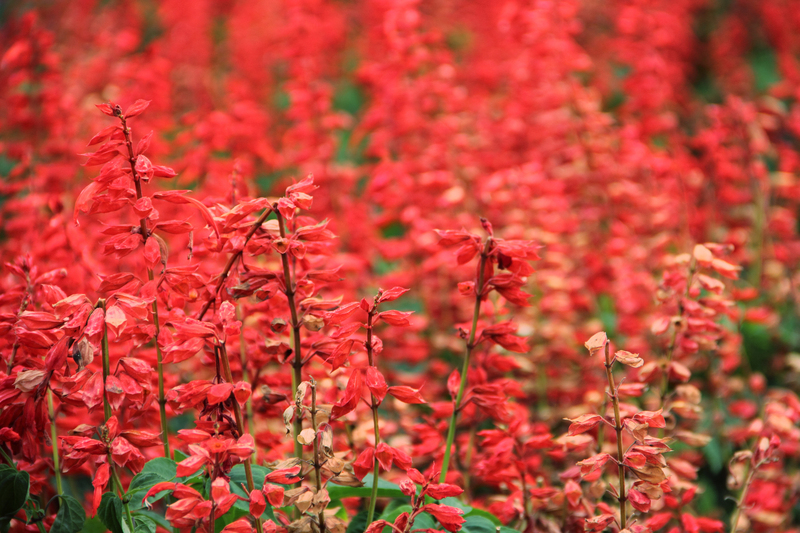Revolutionize Your Garden with Sculptural Hedge Trimming
Posted on 04/07/2025
Transforming your green space into a mesmerizing artwork is more attainable than ever with sculptural hedge trimming. This bold approach to landscaping goes far beyond standard garden maintenance, offering limitless creative possibilities for homeowners and gardening enthusiasts. Discover the secrets to perfecting this art form, the best plants for the job, essential tools, inspiring designs, and practical tips to keep your living sculptures healthy and thriving.
What Is Sculptural Hedge Trimming?
Sculptural hedge trimming, sometimes known as topiary art, is the practice of shaping living plants into defined, often elaborate forms. Unlike conventional hedging--which focuses on straight edges and geometric shapes--sculptural trimming encourages whimsical, artistic creations that can include animals, spirals, abstract figures, and even themed garden scenes. This technique, centuries old yet always fresh in its visual impact, can instantly revolutionize your garden with sophistication, drama, and personal flair.
Why Choose Sculptural Hedge Trimming?
- Expresses Your Personality: Every creation reflects the tastes and priorities of the gardener.
- Enhances Curb Appeal: Unique, sculpted hedges attract admiration and increase property value.
- Promotes Plant Health: Regular trimming encourages denser growth and robust hedges.
- Offers Living Art: Unlike static sculptures, plant-based art changes with the seasons for continual interest.

Essential Plants for Sculptural Hedge Trimming
The choice of plant is the foundation for successful sculptural trimming. The best candidates should boast dense foliage, small leaves, and a willingness to be pruned. Below are the top contenders for artistic garden shaping:
- Buxus sempervirens (Boxwood): Famous for its tight growth habit and resilience. Ideal for small to medium sculptures.
- Taxus baccata (Yew): Equally suitable for intricate and large designs, with lush dark green needles that recover well from pruning.
- Ilex crenata (Japanese Holly): Resembles boxwood and can tolerate extensive shaping.
- Ligustrum (Privet): Fast-growing and forgiving; perfect for bold projects.
- Lonicera nitida (Box Honeysuckle): Suitable for smaller, whimsical shapes, with lovely fine leaves.
Other options include laurels, myrtle, and pittosporum. Choose a variety that thrives in your climate and soil conditions for the best results.
The Art and Science of Sculptural Hedge Trimming
Getting Started: Your Tool Kit
Revolutionize your garden with the right tools. Every sculptural hedge project, big or small, benefits from:
- Sharp hedge shears: Essential for clean cuts and defined lines.
- Topiary clippers or pruners: Ideal for detailed shaping and small spaces.
- String, stakes, or wire frames: Useful when training plants into complex or geometric forms.
- Protective gloves and eyewear: To safeguard hands and eyes during extended trimming sessions.
Advanced projects may require hedge trimmers (electric or manual), ladders, and spirit levels for perfect symmetry.
Basic Principles for Stunning Sculptural Hedges
- Start with a Plan: Sketch your chosen design or use inspiration from formal gardens and online galleries.
- Work Slowly: Begin with simple shapes. Precision matters more than speed.
- Regular Maintenance: Sculptures maintain their crisp appearance with frequent, light trimmings.
- Manage Growth: Thinning out older growth inside the plant helps light and air reach the stems, keeping foliage densified.
- Patience is Key: Complex forms might take months or years to fully realize--enjoy the process as much as the product!
Inspiring Hedge Sculpture Ideas
Let your garden tell a story or evoke an atmosphere unique to you. Here are some trendsetting ideas to spark your next creative hedge project:
- Geometric Masterpieces: Spheres, pyramids, cubes, and cones for a modern or formal aesthetic.
- Animal Topiary: Lions by the entrance, peacocks on the lawn, or rabbits in the herb garden--bring life and whimsy into your landscape.
- Fantasy Forms: Dragons, dragons, spirals, domes, and mythical beasts capture the imagination of young and old alike.
- Arches and Tunnels: Form living gateways and enchanting walk-throughs in larger gardens using curved hedges.
- Letters, Numbers, and Signs: Ideal for personalized garden messages or identifying spaces, such as kitchen gardens or children's play areas.
- Abstract Shapes: Waves, zigzags, or playful asymmetry add avant-garde chic to contemporary gardens.
Famous Examples of Sculptural Hedge Art
- Levens Hall, Cumbria, UK: Boasts some of the oldest and most dramatic topiary gardens in the world.
- Chateau de Villandry, France: Features intricate patterns and grand designs, exemplifying classical French style.
- The Topiary Park, Ohio, USA: An entire park inspired by Seurat's painting, "A Sunday Afternoon on the Isle of La Grande Jatte."
Remember: You don't need to own an estate or castle to create your garden masterpiece--start small and unleash your creativity.
Step-by-Step Guide to Sculptural Hedge Trimming
1. Select and Prepare Your Hedge
Pick a healthy, established plant that matches your preferred shape. Remove dead wood and weak branches, water thoroughly, and feed with an all-purpose fertilizer a few weeks prior to intensive trimming.
2. Define Guidelines
Use string, bamboo canes, or bespoke topiary frames as guides--particularly helpful for symmetrical or complex shapes. Mark boundaries using biodegradable chalk to visualize your masterpiece before making the first cut.
3. Begin Basic Shaping
- Cut Gradually: Trim from the top down, constantly stepping back for perspective.
- Work in Stages: With young or recently planted hedges, only minor shaping is advisable; let the plant grow and mature before committing to a final form.
4. Refine and Detail
Once the core shape is defined, use handheld pruners or snips for finer detailing. Remove only a little foliage at a time to avoid stress to the plant.
5. Sustain Your Creation
- Maintenance Trims: Lightly trim two to three times each growing season (more often with fast growers).
- Fertilization: Feed annually with a balanced fertilizer to support robust foliage.
- Pest and Disease Checks: Monitor for signs of insects or fungal issues and address promptly.
Never prune during extreme drought or the coldest months--prefer late spring to early summer for most species.
Expert Tips to Revolutionize Your Garden With Artful Hedge Trimming
- Use Templates: Cardboard or plywood templates help maintain consistent curves and angles, especially on repeating designs.
- Step Back Often: Regularly appraise your work from different angles to ensure a balanced shape and proper proportions.
- Manage Sunlight: Topiary thrives in full or partial sun--ensure your chosen site supports healthy, even growth.
- Mistakes Are Fixable: Don't panic if you cut too much--a healthy hedge will eventually regrow with a little patience.
- Inspire Children: Get younger family members involved by letting them design or maintain smaller shapes.
Common Mistakes to Avoid
- Over-pruning: Removing too much at once can weaken your hedge; proceed with incremental cuts.
- Neglecting the Base: Narrower bases result in sparse growth; maintain a slightly wider base for stability and even sunlight exposure.
- Trimming in Harsh Weather: Avoid cutting in searing heat or freezing temperatures to prevent plant stress.
- Poor Plant Selection: Not all shrubs respond well to rigorous shaping--choose proven topiary species for best results.
- Impatience: Masterpieces develop over time; hasty shaping can cause plant shock and uneven results.

Frequently Asked Questions (FAQ)
How long does it take to grow a garden hedge suitable for sculptural trimming?
Most popular hedging plants, like boxwood and yew, take two to five years to grow thick and robust enough for advanced sculptural work, although simple shapes can be started earlier.
Which is easier for beginners: simple geometric shapes or animal forms?
Start with spheres, cones, cubes, or spirals. Once you've mastered symmetry and basic techniques, gradually tackle more intricate designs like animals or abstract art.
How often should I trim sculptural hedges?
Plan to trim two to four times per growing season (spring through early autumn), being careful not to remove more than a third of the plant's growth at each session.
What is the best time of year for hedge sculpture maintenance?
Early summer is optimal for most hedges, with periodic trims through late summer. Avoid pruning in late autumn, as tender new growth may fail to harden before winter.
Is sculptural hedge trimming sustainable?
Yes, with the right plant selection and care, topiary art can last for decades, providing habitat for wildlife and year-round garden structure. Use organic fertilizers and water responsibly to maximize sustainability.
Conclusion: Let Your Garden Tell a Story
Sculptural hedge trimming isn't just a gardening task--it's a creative journey that breathes life, character, and distinction into your outdoor space. By thoughtfully selecting plants, equipping yourself with the right tools, and nurturing your living artwork with regular care, you can revolutionize your garden with striking sculptural designs that turn heads and ignite imaginations.
Ready to start your own green masterpiece? Whether you're aiming for classic shapes or daring contemporary pieces, the world of hedge sculpture is as wide as your imagination. Share your creations, inspire your community, and enjoy the transformative power of living art in your garden for years to come!
- Begin today--your garden is your canvas!
- Let sculptural hedge trimming make your landscape extraordinary.

